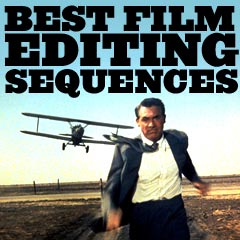
|
| Film Title/ Director & Editor and Film Description | ||||||||

|
JFK (1991) d. Oliver Stone
Director/co-writer Oliver Stone's complex, provocative docu-film thriller was a controversial, speculatively revisionistic, historical epic surrounding one-time New Orleans DA Jim Garrison's (Kevin Costner) investigation of the John F. Kennedy assassination on November 22, 1963. Its intriguing interpretation was based on the well-publicized and alleged conspiracy theories of the obsessed attorney about the mystery of the death, and on the testimony of a number of unreliable witnesses. Stone employed innovative, masterful and impressive film editing (with quick cuts and use of various film stocks) through the work of Joe Hutshing and Pietro Scalia (who won Oscars), and he created, through gripping cinematography, a tense, kinetic atmosphere that mirrored the whirlwind of memories, incidents and scenarios that played out in the DA's mind. The film masterfully assembled, edited and merged, like a jigsaw puzzle, various sources of material (newsreels, photos, black and white, color, 8 mm, 16 mm, etc., minature models, and re-enactments) into one film to create a semblance of truth, but not necessarily real history. However, Stone was attacked and dismissed by the American media, CBS, The New York Times, Time, Newsweek and The Washington Post, for deliberately combining factual and historical footage with hypothetical footage to make it appear to be one seamless, objective and truthful record of events. In response, Stone released the screenplay, annotated with its factual sources. The trial scene in the last half of the film featured three very memorable segments to disprove the idea that assassin Lee Harvey Oswald (Gary Oldman) acted alone:
|
 Courtroom Scene - Film  B/W Re-enactment 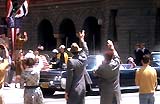 Color Re-enactment  8mm Zapruder film  Scale model  B/W Newsreel 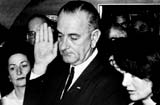  Historic Still Photographs 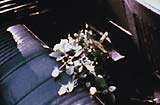 Color Newsreel |
||||||
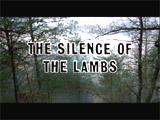
|
The Silence of the Lambs (1991) d. Jonathan Demme
In the Shelby County Courthouse, the fourth and final encounter between FBI agent-trainee Clarice Starling (Jodie Foster) and ex-psychiatrist Dr. Hannibal Lecter (Anthony Hopkins), played out like a profound, perverted parody of a "love scene," sexual power struggle, or a complex chess game. In the middle of the Historical Society Room on the fifth floor, a massive temporary iron cage had been erected, cordoned off by black and white striped police barricades. Inside the cage, Dr. Lecter sat at a table reading, his back to her. Without turning, he greeted her: "Good evening, Clarice." In the remarkable scene in the tightly-guarded room, both alternatingly traded information and confided in each other - learning vital secrets that each one coveted. The camera moved to closer angles on their faces as the scene progressed and the intimacy level intensified. A domineering close-up filled the screen with Lecter's forehead as the intimidating doctor compared everything to Clarice's failed attempt to rescue a frantic, bleating and "screaming" lamb from the slaughter when she was a child to her present day motives regarding the rescue of another innocent victim, Catherine Martin (Brooke Smith):
The camera slowly progressed beyond and through the bars until it appeared that the menacing doctor had broken through the cell bars to psychologically assault the vulnerable Clarice:
|
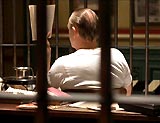 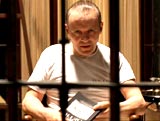 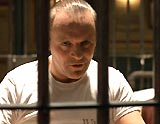 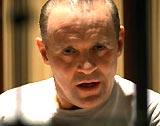 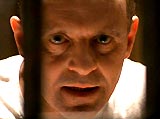 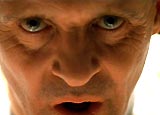 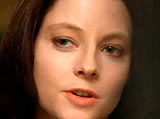
|
||||||

|
The Silence of the Lambs (1991) d. Jonathan Demme
The climactic, terrifying chase sequence in a dungeon-like hideaway between FBI agent trainee Clarice Starling (Jodie Foster) and serial killer madman Jame Gumb (Ted Levine) (aka Buffalo Bill) was prefaced by an amazing, deliberate scene of editing mis-direction in two linear sequences of separate events. The FBI closed in on Gumb's empty home in Illinois, where they rang the doorbell (with a fake flower deliveryman), and ultimately broke through the door and other windows. Simultaneously, the film cut to Clarice innocently ringing the doorbell at Gumb's home in Ohio, where he opened the door and identified himself as "Jack Gordon."
As she was innocently questioning Gumb at his door, the film cut back to the FBI in Illinois, where lead agent Jack Crawford (Scott Glenn) was told: "There's no one here, Jack." A zoom to his concerned and worried face emphasized that he was mistaken, Clarice was in danger ("Clarice!") - and he was helpless. Back at the Gumb house after Clarice was let in, she sensed that Gumb was her suspect and held her gun on him. He fled into the multi-room cellar where Clarice cautiously followed him down the stairwell with her gun drawn. Swiveling from side to side with her gun for protection, Clarice found herself in Gumb's laboratory and skinning room, where big moths flew overhead, and a 'skin suit' was briefly seen on a dressmaker's dummy. In a bathroom off the workroom, a female hand and wrist extended up out of a murky mixture in a bathtub. As Clarice reacted in horror to the sight, the lights went out and she found herself in total darkness. Gumb had fitted himself with night-vision goggles (seen before when Catherine was abducted), and from his perspective, everything appeared in a greenish tint, and he watched her as she flattened herself against a wall and tried to get her bearings. [Note: The sequence was reminiscent of the final fifteen minutes of Wait Until Dark (1967).] The serial killer reached out with one hand to stroke her hair and the skin of her face. His fingers floated through the air just inches from in front of her. Then he paused, raised his gun in the air, and cocked the hammer. Its loud metallic click tipped Clarice to his location. She spun around - in slow motion - and fired flaming shots from her gun muzzle at him, at point-blank range, killing him. She looked around - viewing newspaper clippings commemorating his own killings, a lingering medium shot of a child's-size American flag leaning against a dusty Army helmet, and a close-up of a revolving, turquoise-blue, "Chinatown" paper mobile emblazoned with a butterfly design. |
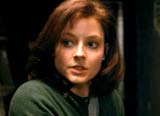 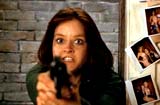 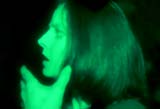 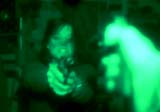 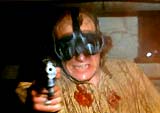
|
||||||
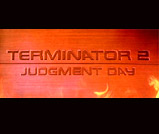
|
Terminator 2: Judgment Day (1991) d. James Cameron
Two of this action film's best sequences were masterfully edited, showing a neat role reversal:
This was revealed in The Galleria chase sequence with both Terminators, including a second bad-guy Terminator called T-1000 (Robert Patrick) (dressed as a cop), who were in pursuit of John. The newer model Terminator was a liquid metal model with pseudomorphic capabilities. The young boy found himself in the direct line of fire as both Terminators aimed their guns at him! The Terminator shielded John's body and blocked the bullets as the cop emptied his pistol into the cyborg's back - the Terminator then turned and fired repeated shotgun blasts into the cop's body. The sequence concluded with the high-speed Flood Control Channel Chase involving a commandeered big-rig tow truck. The T-800 sailed his bike down into the canal, miraculously keeping the bike upright when it bottomed out on the ground. He caught up to John, swept the kid off his motorbike and swung him onto his own Harley. The big rig at full speed crashed into the divider which bisected the canal into two channels - the small Harley passed through one of the channels ahead of the massive truck. The rig exploded into flames ignited after the collision, although the figure of the T-1000 emerged from the flames as a smooth, chrome-surfaced man - a featureless, liquid mercury-like shape, until transforming back into the cop. |
  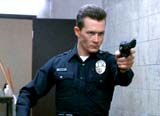 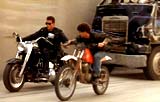 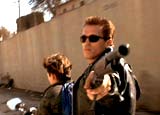 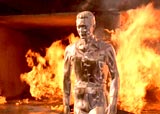
|
||||||

|
d. Paul Verhoeven
This erotic thriller was most famous for the police interrogation scene in which ice pick murderess suspect and novelist Catherine Tramell (Sharon Stone) had waived her right to an attorney and was seated in a chair in front of a room full of male police detectives. She was poised, cool, and sat there in command of the situation, refusing to stop smoking even though there was no smoking permitted in the building: "What are you going to do? Charge me with smoking?" She matter-of-factly flirted and manipulatively toyed with the libidos and sexual appetites of the men as she tersely revealed her past sexual activities with the murder victim Johnny Boz and played sex games with their minds. After admitting to cocaine use with Mr. Boz, she surprised the attentive audience by directing a follow-up question toward tough police detective Nick Curran (Michael Douglas): "Have you ever f--ked on cocaine, Nick?" She smiled and revealingly uncrossed her legs, flashing her panty-less private parts at him -- and then she re-crossed her legs in the opposite direction, causing a stir in the room. |
 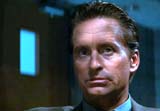 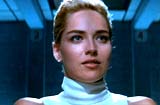 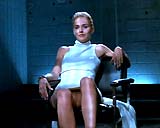 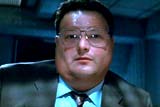 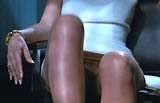 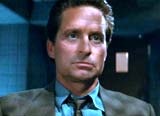
|
||||||

|
d. Steven Spielberg
In a scene with skillful parallel editing and overlapping voice-over dialogue, gadabout Oskar Schindler (Liam Neeson) entertained and seduced SS German officers with rich food, caviar and drink in his apartment. As part of an elaborate confidence game, he provided some of his pretty secretaries to the men, as he read off a list of black market items (including perishables and cognac) that he wanted Polish Jew Poldak Pfefferberg (Jonathan Sagalle) to acquire (with invested Jewish money) from Poles and provide as bribes:
Under a bridge crossing the Vistula River, a man pulled aside a tarpaulin covering boxes of fresh fruit in the bottom of his rowboat and was paid with cash. A bribed doctor opened a medicine cabinet and pushed aside medicines, revealing a hidden compartment behind holding several bottles of Hennessey cognac. Beneath the ties of train tracks, a metal case was pulled from beneath one of the timbers, revealing a case of sardines. (Schindler's voice-over described his business proposition as his factory opened):
Elaborate gift baskets (of liquor, cigarettes, coffee, tea, fresh fruit, and other rare luxury goods) with the accompanying letter from above - were assembled and carried by Schindler's cadre of pretty secretaries through the factory and strategically delivered to SS officers (the ones he had earlier been photographed with in the nightclub) to irresistibly stimulate bids and purchase contracts. The ultimate con artist, Schindler bribed and schemed his way toward wealth. The Direktor strode through his factory, dictating to a parade of his secretaries about production demands and delivery details. As expected, one of the many SS officers, Julian Scherner (Andrzej Seweryn), signed and stamped his approval of a materials contract with D.E.F. |
  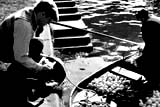 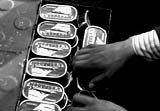 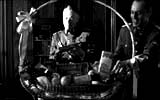 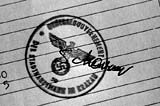
|
||||||

|
d. Steven Spielberg
Before composing a list to save as many of his Polish Jew workers as possible, Oskar Schindler (Liam Neeson) met with his Jewish accountant Itzhak Stern (Ben Kingsley) in his office in Plaszow. Both were resigned to their fates from the Nazis. Schindler reassured his beloved accountant that he would make sure that he received "special treatment" or "preferential treatment" and then wearily said: "Someday this is all going to end, you know. I was going to say we'll have a drink then," but Stern responded: "I think I'd better have it now." In the powerfully-edited scene between the two men, unlike so many other times, Stern now accepted a glass of cognac, raised it slightly to acknowledge Schindler, and then drank. |
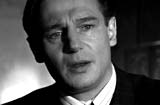 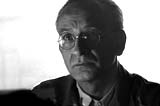 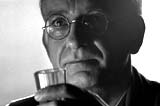 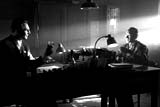
|
||||||